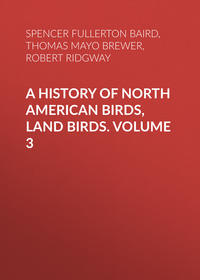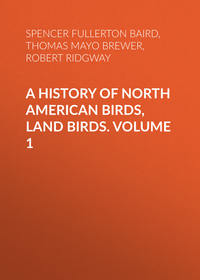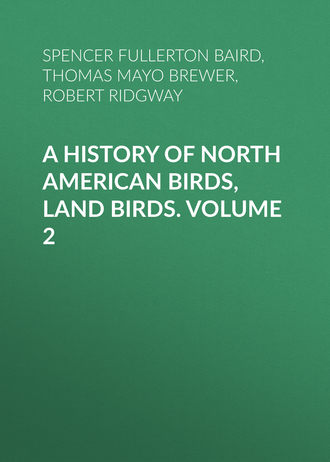 полная версия
полная версияA History of North American Birds, Land Birds. Volume 2
Wilson states that they often nest in eaves, and occasionally in an open well, five or six feet down, among the interstices of the side-walls. Nuttall has known them to nest in an empty kitchen.
Their attachment to a locality, when once chosen, is remarkable, and is often persevered in under the most discouraging circumstances. In one instance, Nuttall states that a nest was built in the boathouse at Fresh Pond, Cambridge,—a place so common as to be almost a thoroughfare. Although with its young brood this nest was torn down by ruffian hands, the female immediately built a new one in the same spot, and laid five additional eggs. This was lined with the silvery shreds of a manilla rope, taken from the loft over the boathouse.
Besides the common call-note, from which these birds derive their name, they have, during the love-season, a low twittering song with which they entertain their mates, but which is heard only when the birds are in company, and for a brief season.
The flight of the Pewee is an alternation of soaring and a succession of light fluttering motions, more rapid when pursuing its prey than in its ordinary movements. Its crest is usually erected when it is in motion, or on the lookout for insects.
Mr. Audubon found these birds in full song in Florida during the winter, and as lively as in spring, but met with none breeding south of Charleston. They leave Louisiana in February, and return to it in October. They feed largely on berries, especially during the winter, and Mr. Maynard found some in the spring of 1868 with hawthorn berries in their stomachs.
The eggs of the Pewee measure .80 of an inch in length and .60 in breadth. They are of a rounded oval shape, pointed at one end and much larger at the other. Their ground-color is a pure bright white, and generally unspotted; but a certain proportion, one set in every five or six, is distinctly marked with reddish-brown dots at the larger end.
Sayornis sayus, BairdSAY’S PEWEEMuscicapa saya, Bonap. Am. Orn. I, 1825, 20, pl. xi, fig. 3.—Aud. Orn. Biog. IV, 1838, 428, pl. ccclix.—Ib. Birds Am. I, 1840, 217, pl. lix. Tyrannus saya, Nuttall, Man. I, (2d ed.,) 1840, 311. Myiobius saya, Gray, Genera, I, 1844-49, 249. Ochthœca sayĭ, Cabanis, Wiegmann Archiv, 1847, I, 255 (not type). Tyrannula saya, Bonap. Conspectus, 1850.—Max. Cab. J. VI, 1858, 183. Aulanax sayus, Cabanis, Journ. Orn. 1856, 2. Tyrannula pallida, Swainson, Syn. Birds Mex. No. 15, in Taylor’s Phil. Mag. I, 1827, 367. Sayornis pallida, Bonap.—Scl. P. Z. S. 1857, 204. Sayornis sayus, Baird, Birds N. Am. 1858, 185.—Ib. M. B. II, Birds, 9.—Cooper, Orn. Cal. 1, 1870, 320. Theromyias saya, Caban. M. H. II, Sept. 1859, 68 (type).
Sp. Char. Above and on the sides of the head, neck, and breast, grayish-brown, darker on the crown; region about the eye dusky. The chin, throat, and upper part of the breast similar to the back, but rather lighter and tinged with the color of the rest of the lower parts, which are pale cinnamon. Under wing-coverts pale rusty-white. The wings of a rather deeper tint than the back, with the exterior vanes and tips of the quills darker. Edges of the greater and secondary coverts, of the outer vane of the outer primary, and of the secondaries and tertials, dull white. The upper tail-coverts and tail nearly black. Edge of outer vane of exterior tail-feather white. Bill dark brown, rather paler beneath. The feet brown. Second, third, and fourth quills nearly equal; fifth nearly equal to sixth; sixth much shorter than the fifth. Tail broad, emarginate. Tarsi with a posterior row of scales. Length, 7 inches; wing, 4.30; tail, 3.35.
Hab. Missouri and central High Plains, westward to the Pacific and south to Mexico. Xalapa (Scl. 1859, 366); Orizaba (Scl. List, 199); Vera Cruz, winter? (Sum. M. Bost. Soc. I, 557); S. E. Texas (Dresser, Ibis, 1865, 473, breeds); W. Arizona (Coues, P. A. N. S. 1866, 60).
The young of the year have the upper parts slightly tinged with ferruginous; two broad (ferruginous) bands on the wings formed by the tips of the first and second coverts. The quills and tail rather darker than in an adult specimen.
Autumnal specimens are simply more deeply colored than spring examples, the plumage softer and more blended.
Habits. Say’s Flycatcher has an extended distribution throughout western North America, from Mexico, on the south, to the plains of the Saskatchewan on the north, and from the Rio Grande and the Missouri to the Pacific Ocean.
It was first discovered by Mr. Titian Peale on the Arkansas River, near the Rocky Mountains, and described by Bonaparte. Mr. Peale noticed a difference in its voice from that of the common S. fuscus, and found it nesting in a tree, building a nest of mud and moss, lined with dried grasses. Its young were ready to fly in July. Richardson obtained individuals of this species at the Carlton House, May 13. It is not given by Cooper and Suckley in their Zoölogy of Washington Territory, but Dr. Newberry found it not uncommon throughout both Oregon and California.
Mr. Sumichrast ascertained the presence of this bird within the Department of Vera Cruz, but whether there as resident or as exclusively migratory he was not able to state. It has also been found in winter throughout Mexico. Mr. J. H. Clark met with it near Fort Webster, in New Mexico, and describes it as particularly abundant about the copper mines. One of the shafts near the fort, and which was partially filled up, served as a sinkhole for the offal of the town, and around this quite a number of these birds could always be seen in pursuit of flies and insects attracted to the place. Mr. Clark observed that their sudden darting from their perch and their instantaneous return were not always attended with the capture of an insect, but seemed at times to be done only for amusement or exercise. Mr. Dresser first noticed these birds in November, when walking in the gardens of the arsenal at San Antonio. On his journey to Eagle Pass in December, he saw several daily, generally in pairs. They would perch on a bush by the roadside, occasionally darting off after some insect, and, as soon as he drew near, would fly off to a convenient perch some distance ahead, thus keeping in advance for miles. During the months of January and February they were not uncommon, but after that he lost sight of them altogether. They seemed to prefer the open country, as he generally found them on the prairies, and never in the mesquite thickets. Their stomachs were found to contain small insects.
Dr. Woodhouse frequently met with these birds in Western Texas and in New Mexico. They seemed more silent and more shy than the fuscus, but otherwise similar in their habits.
Dr. Kennerly met with this species at Bill Williams’s Fork, New Mexico, February 10, 1854. He states that he found them common in Texas, and as far to the westward as the Great Colorado River. They built their nests under the cliffs along the stream, and in notes and in every other respect closely resembled the common Pewee.
Dr. Heermann mentions finding this species abundant in Southern California. It was more especially plentiful in the fall, at the time of its migration southward. He also found it in New Mexico, in the northern part of Texas, near El Paso, and in Sacramento Valley, though somewhat rare. In migrating, it prefers the deep valleys bordered by high hills, but also occurs on the open plains, where, perched on the stalk of some dead weed, or on a prominent rock, it darts forth in pursuit of its prey, to return to the same point.
In Arizona, Dr. Coues found this Flycatcher common throughout the Territory. At Fort Whipple it was a summer resident. It was one of the first of the migratory birds to make its appearance in spring, arriving early in March, and remained among the last, staying until October. It winters in the Colorado Valley and the southern portions of the Territory generally. He found it frequenting almost exclusively open plains, in stunted chaparral and sage brush. In some other points of habits it is said to differ remarkably from our other Flycatchers. It does not habitually frequent cañons, rocky gorges, and secluded banks of streams, as does S. fuscus, nor does it inhabit forests, like other Flycatchers.
Dr. Cooper regards this bird as mostly a winter visitor in the southern and western parts of California, where he has seen none later than March. In summer it is said to migrate to the great interior plains as far to the north as latitude 60°. It arrives from the north at Los Angeles in September, and perhaps earlier in the northern part of the State, and possibly breeds there east of the Sierras. Mr. Allen found it common in Colorado Territory, among the mountains.
In the arid portions of the Great Basin this species was often seen by Mr. Ridgway. In its natural state it preferred rocky shores of lakes or rivers, or similar places in the cañons of the mountains, where it attached its bulky down-lined nests to the inside of small caves or recesses in the rocks, usually building them upon a small projecting shelf. Wherever man has erected a building in those desert wastes,—as at the stage-stations along the road, or in the mining towns,—it immediately assumed the familiarity of our eastern Pewee, at once taking possession of any outbuilding or any abandoned dwelling. Its notes differ widely from those of the S. fuscus and S. nigricans, the common one consisting of a wailing peer, varied by a tremulous twitter, and more resembling certain tones of the Wood Pewees (Contopus virens and richardsoni), with others which occasionally call to mind the Myiarchus cinerascens.
This species has been observed as far to the east as Racine, Wisconsin, where it was taken by Dr. P. R. Hoy. The specimen was sent to Mr. Cassin, and its identity fully established. Dr. Palmer found it breeding near Fort Wingate, in Arizona, June 11, 1869, and Mr. Ridgway obtained its nests and eggs at Pyramid Lake, Nevada, May 23, 1868. One of these nests (No. 13,588) he describes as a nearly globular mass, more flattened on top, 3.50 inches in depth by 4.00 in diameter, and composed chiefly of spiders’ webs, with which is mixed very fine vegetable fibres, of various descriptions. This composition forms the bulk of the nest, and makes a closely matted and tenacious, but very soft structure; the neat but rather shallow cavity is lined solely with the grayish-white down of wild ducks. The nest was placed on a shelf inside a small cave on the shore of the island, at about ten or twelve feet from the water.
Their eggs are rounded at one end and pointed at the other, measure .82 of an inch in length by .65 in breadth. They are of a uniform chalky white, and, so far as I am aware, entirely unspotted.
Genus CONTOPUS, CabanisContopus, Cabanis, Journ. für Ornith. III, Nov. 1855, 479. (Type, Muscicapa virens, L.)
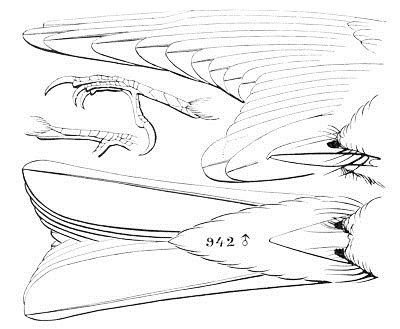
Contopus borealis.
942 ♂
Gen. Char. Tarsus very short, but stout; less than the middle toe and scarcely longer than the hinder; considerably less than the culmen. Bill quite broad at the base; wider than half the culmen. Tail moderately forked. Wings very long and much pointed, reaching beyond the middle of the tail; the first primary about equal to the fourth. All the primaries slender and rather acute, but not attenuated. Head moderately crested. Color olive above, pale yellowish beneath, with a darker patch on the sides of the breast. Under tail-coverts streaked in most species. A tuft of cottony-white feathers on each side of the rump (concealed in most species).
This genus is pre-eminently characterized among North American Flycatchers by the very short tarsi, and the long and much pointed wings.
In most other genera, as Sayoris, Myiarchus, and Empidonax, a trace of a cottony tuft may be discovered by careful search on the flanks; but in the present genus, there is, in addition, the tufts on the rump, not found in the others. The species are as follows:—
Species and VarietiesA. Cottony patch of white feathers on sides of the rump greatly developed, and conspicuous. Rictal bristles very short (about one fourth the length of the bill). Lower parts distinctly and abruptly white medially (somewhat interrupted on the breast).
1. C. borealis. First quill longer than the fourth, generally exceeding the third. Wing, 4.00 to 4.40; tail, 2.90 to 3.00; culmen, .90; tarsus, .60. Above dark olive-plumbeous, the tertials edged with whitish; lower parts a lighter shade of the same, laterally and across the breast (narrowly), the throat and middle line of the abdomen being abruptly white. Young not different. Hab. Northern parts of North America, to the north border of United States; on the mountain-ranges, farther south, on the interior ranges, penetrating through Mexico to Costa Rica.
B. Cottony patch on side of rump rudimentary and concealed. Rictal bristles strong (one half, or more, the length of the bill). Lower parts not distinctly white medially.
a. First primary shorter than fifth, but exceeding the sixth. Tail shorter than wings.
2. C. pertinax. Wing more than 3.50. Grayish-olive, becoming lighter on the throat (indistinctly) and abdomen (decidedly). No distinct light bands on the wing. Rictal bristles about half the length of bill.
The olive of a grayish cast, and not darker on the crown. Wing, 4.45; tail, 3.90; depth of its fork, .35; culmen, .92; tarsus, .70. Hab. Mexico, generally north into Arizona (Fort Whipple, Coues) … var. pertinax.
The olive of a sooty cast, and darker on the crown. Wing, 3.60; tail, 3.10; its fork, .20; culmen, .83; tarsus, .61. Hab. Costa Rica … var. lugubris.81
3. C. brachytarsus. Wing less than 3.00; colors much as in pertinax, var. pertinax, but wing-bands distinct, breast less grayish, and pileum decidedly darker than the back. Rictal bristles two thirds as long as the bill.
Wing, 2.65; tail, 2.55; culmen, .60; tarsus, .53. Hab. Panama … var. brachytarsus.82
Wing, 2.90; tail, 2.55; culmen, .67; tarsus, .53. Hab. Yucatan … var. schotti.83
b. First primary shorter than the sixth. Tail variable.
4. C. caribæus. Bill much depressed, very long and broad, the sides more nearly parallel on the basal than on the terminal half; rictal bristles very strong (two thirds, or more, the length of the bill). Above olivaceous, generally rather dark, but varying in tint. Beneath whitish, or dull light-ochraceous, more brownish along the sides and (more faintly) across the breast. Axillars and lining of the wing deep light-ochraceous.
Tail longer than wings; bill moderately depressed; rictal bristles three fourths as long as the bill.
Dark greenish-olive above; beneath dingy ochrey-yellowish. Wing, 2.80; tail, 2.90; culmen, .78; tarsus, .58. Hab. Cuba … var. caribæus.84
Dark olive-gray above; beneath whitish, with scarcely any yellowish tinge. Wing, 3.00; tail, 3.05; culmen, .70; tarsus, .59. Hab. Hayti … var. hispaniolensis.85
Brownish-olive above; beneath deep dingy ochrey-yellowish. Wing, 2.85; tail, 2.90; culmen, .66; tarsus, .56. Hab. Jamaica … var. pallidus.86
Tail shorter than wing; bill excessively depressed; rictal bristles only one half as long as the bill.
Olive-plumbeous above; beneath dingy white (not interrupted on the breast); tinged posteriorly with sulphury (not ochrey) yellow; wing-bands pale ash. Wing, 2.80; tail, 2.65; culmen, .79; tarsus, .63. Hab. Bahamas … var. bahamensis.87
C. First quill much longer than fifth (sometimes equal to fourth). Tail much shorter than the wing. Bill much smaller, less depressed, and more triangular; rictal bristles about one half the bill.
5. C. virens. Colors of caribæus var. bahamensis, but rather more olivaceous above, and more distinctly tinged with sulphur-yellow posteriorly beneath. Lining of the wings, and axillars, without any ochraceous tinge; lower tail-coverts distinctly grayish centrally.
Whitish of the lower parts not interrupted on the breast. Wing, 3.40; tail, 2.90; culmen, .67; tarsus, .54. Hab. Eastern Province of United States … var. virens.
Whitish of medial lower parts interrupted by a grayish wash across the breast. Wing, 3.40; tail, 2.65 to 2.70; culmen, .70; tarsus, .54 to .56. Hab. Western Province of United States, south throughout Middle America to Ecuador … var. richardsoni.88
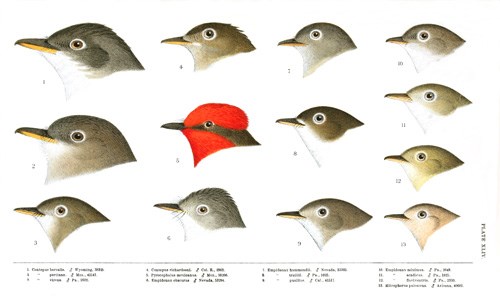
PLATE XLIV.
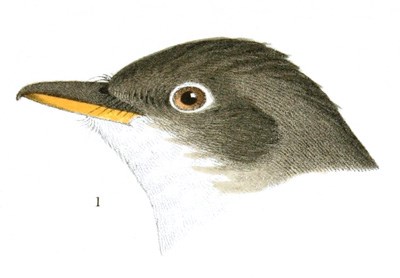
1. Contopus borealis. ♂ Wyoming, 38325.
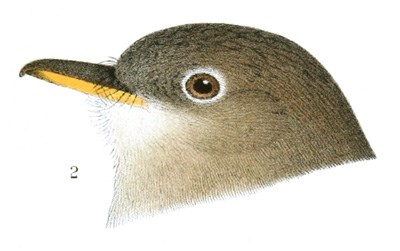
2. Contopus pertinax. ♂ Mex., 42141.
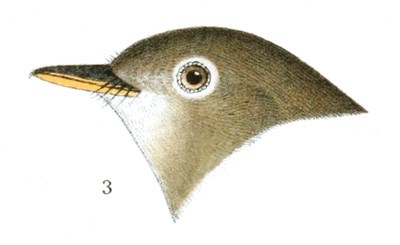
3. Contopus virens. ♂ Pa., 1632.

4. Contopus richardsoni. ♂ Col. R., 2962.
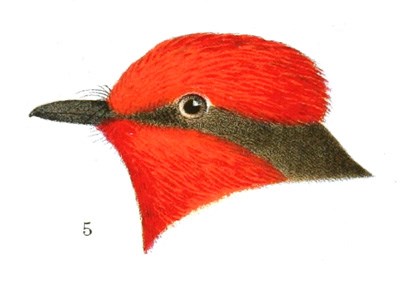
5. Pyrocephalus mexicanus. ♂ Mex., 38206.
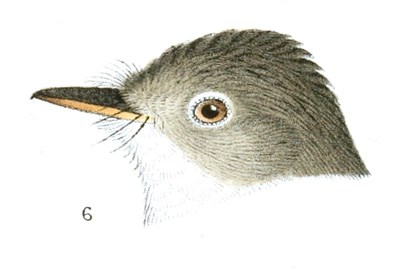
6. Empidonax obscurus. ♂ Nevada, 53294.
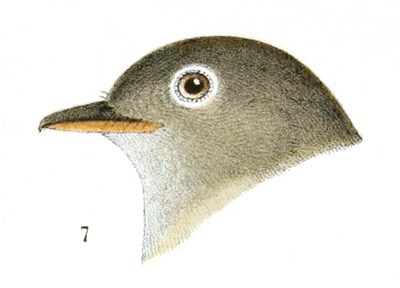
7. Empidonax hammondii. ♂ Nevada, 53305.
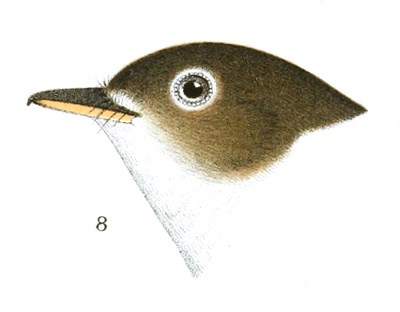
8. Empidonax traillii. ♂ Pa., 1025.
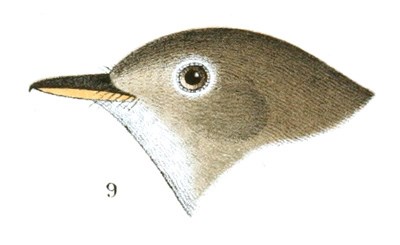
9. Empidonax pusillus. ♂ Cal., 41517.
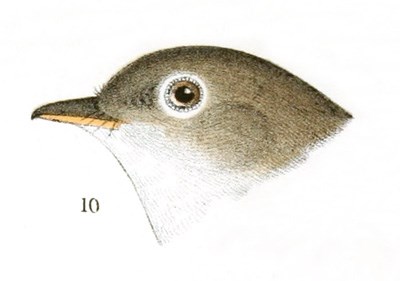
10. Empidonax minimus. ♂ Pa., 2649.
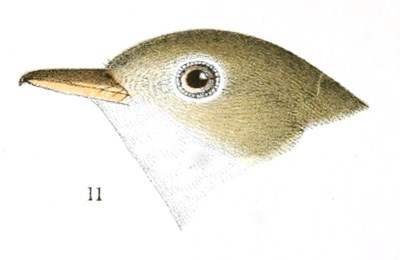
11. Empidonax acadicus. ♂ Pa., 1825.
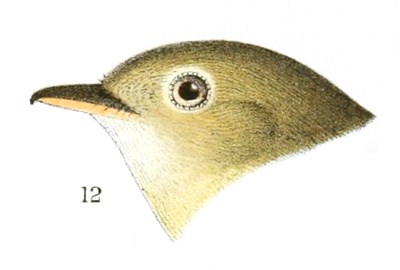
12. Empidonax flaviventris. ♂ Pa., 2330.
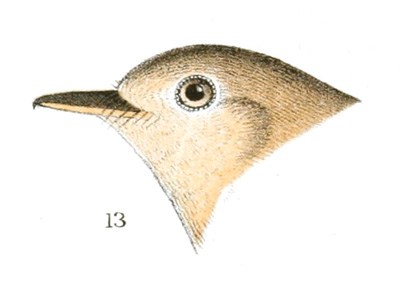
13. Mitrephorus palescens. ♂ Arizona, 40601.
Contopus borealis, BairdOLIVE-SIDED FLYCATCHER
Tyrannus borealis, Sw. & Rich. F. Bor.-Am. II, 1831, 141, plate. Myiobius borealis, Gray, Genera, I, 248. Muscicapa cooperi, Nuttall, Man. I, 1832, 282.—Aud. Orn. Biog. II, 1834, 422; V, 1839, 422, pl. clxxiv.—Ib. Synopsis, 1839, 41.—Ib. Birds Am. I, 1840, 212, pl. lviii. Tyrannus cooperi, Bonap. List, 1838.—Nuttall, Man. I, (2d ed.,) 1840, 298. Contopus cooperi, Cabanis, Journal für Ornithol. III, Nov. 1855, 479. Muscicapa inornata, Nuttall, Man. I, 1832, 282. Contopus borealis, Baird, Birds N. Am. 1858, 188.—Cooper & Suckley, 169.—Sclater, Catal. 1862, 230.—Samuels, 135.—Cooper, Orn. Cal. 1, 1870, 323. Contopus mesoleucus, Sclater, P. Z. S. 1859, 43.—Ib. Ibis, 1859, 122, 151. Tyrannus nigricans, Max. Cab. J. VI, 1858, 184.
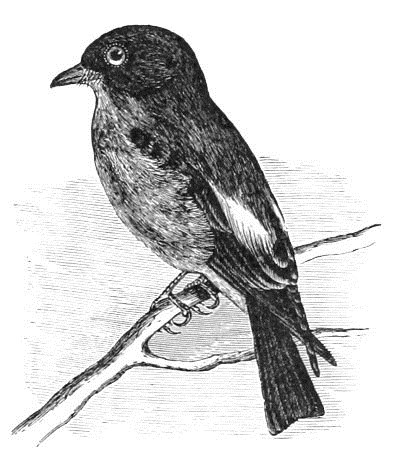
Contopus borealis.
Sp. Char. Wings long, much pointed; the second quill longest; the first longer than the third. Tail deeply forked. Tarsi short. The upper parts ashy-brown, showing darker brown centres of the feathers; this is eminently the case on the top of the head; the sides of the head and neck, of the breast and body, resembling the back, but with the edges of the feathers tinged with gray, leaving a darker central streak. The chin, throat, narrow line down the middle of the breast and body, abdomen, and lower tail-coverts white, or sometimes with a faint tinge of yellow. The lower tail-coverts somewhat streaked with brown in the centre. On each side of the rump, generally concealed by the wings, is an elongated bunch of white silky feathers. The wings and tail very dark brown, the former with the edges of the secondaries and tertials edged with dull white. The lower wing-coverts and axillaries grayish-brown. The tips of the primaries and tail-feathers rather paler. Feet and upper mandible black, lower mandible brown. The young of the year similar, but the color duller; edges of wing-feathers dull rusty instead of grayish-white. The feet light brown. Length, 7.50; wing, 4.33; tail, 3.30; tarsus, .60.
Hab. Northern portions of whole of North America, throughout Rocky Mountains, south through elevated regions of Mexico to Costa Rica. Localities: Oaxaca, high regions, Oct. (Scl. 1858, 301); Xalapa (Scl. 1859, 366); Guatemala (Scl. Ibis, I, 122); Costa Rica (Lawr. IX, 115); Veragua (Salv. 1870, 199); San Antonio, Texas (Dresser, Ibis, 1865, 474, winter).
There is wonderfully little variation in this species, both in coloration and size, with different regions; in fact none other than individual can be observed. Contrary to the usual rule, spring specimens have a more appreciable sulphur-yellow tinge below.
Habits. This still comparatively rare species was first obtained by Richardson and described by Swainson. The specimen was shot on the Saskatchewan. No other was taken, and no information was obtained in reference to its habits. It appears to have been next met with by Mr. John Bethune, in Cambridge, June 7, 1830, in the woods of Mount Auburn. This and a second specimen, obtained soon after, were females, on the point of incubation. A third female was shot in the following year, June 21. Supposed to be a new species, it was described by Mr. Nuttall as Tyrannus cooperi. All the specimens procured had their stomachs filled with torn fragments of bees, wasps, and similar insects.
Mr. Nuttall, who watched the motions of two other living individuals of this species, states that they appeared tyrannical and quarrelsome even with each other. Their attacks were always accompanied with a whining, querulous twitter. The disputes seemed to be about the occupancy of certain territories. One bird, a female, appeared to confine herself to a small clump of red cedars, in the midst of a sandy piece of forest. From the tree-tops she kept a sharp lookout for passing insects, and pursued them, as they appeared, with great vigor and success, sometimes chasing them to the ground, and returning to her perch with a mouthful which she devoured at her leisure. When she resumed her position, she would occasionally quiver her wings and tail, erect her crest, keeping up a whistling call of pŭ-pŭ, uttered with variations. Besides this call the male had a short song which sounded like ch’-phe’bēē.
The nest of this pair Mr. Nuttall discovered in the horizontal branch of a tall red cedar, fifty feet from the ground. It was made externally of interlaced dead twigs of the cedar, lined with wiry stems, and dry grasses, and fragments of lichens. It contained three young, which remained in the nest twenty-three days, and were fed on beetles and other insects. Before they left their nests they could fly as well as their parents. The male bird was very watchful, and would frequently follow Mr. Nuttall half a mile. They were in no way timid, and allowed him to investigate them and their premises without any signs of alarm.
In 1832 the same pair, apparently, took possession of a small juniper, near the tree they had occupied the year before, in which, at the height of fifteen feet, they placed their nest. It contained four eggs which, except in their superior size, were precisely similar to those of the Wood Pewee, yellowish cream-color, with dark brown and lavender-purple spots, thinly dispersed. After removing two of these eggs, the others were accidentally rolled out of the nest. The pair constructed another nest, again in a cedar-tree, at a short distance. The next year they did not return to that locality. Mr. Nuttall afterwards met with individuals of this species in the fir woods on the Columbia.


